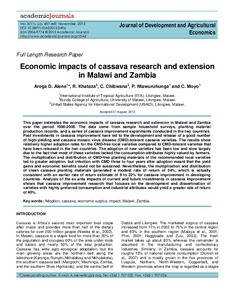| dc.contributor.author | Alene, A. |
| dc.contributor.author | Khataza, R. |
| dc.contributor.author | Chibwana, C. |
| dc.contributor.author | Ntawuruhunga, Pheneas |
| dc.contributor.author | Moyo, C. |
| dc.date.accessioned | 2019-12-04T11:03:41Z |
| dc.date.available | 2019-12-04T11:03:41Z |
| dc.date.issued | 2013-11 |
| dc.identifier.citation | Alene, A., Khataza, R., Chibwana, C., Ntawuruhunga, P., & Moyo, C. (2013). Economic impacts of cassava research and extension in Malawi and Zambia. Journal of Development and Agricultural Economics, 5(11), 457-469. |
| dc.identifier.issn | 2006-9774 |
| dc.identifier.uri | https://hdl.handle.net/20.500.12478/1194 |
| dc.description.abstract | This paper estimates the economic impacts of cassava research and extension in Malawi and Zambia over the period 1990-2008. The data come from sample household surveys, planting material production records, and a series of cassava improvement experiments conducted in the two countries. Past investments in cassava improvement have led to the development and release of a good number of high-yielding and cassava mosaic virus disease (CMD)-tolerant cassava varieties. The results show relatively higher adoption rates for the CMD-free local varieties compared to CMD-tolerant varieties that have been released in the two countries. The adoption of new varieties has been low and slow largely due to the fact that most of these varieties lacked the consumption attributes highly valued by farmers. The multiplication and distribution of CMD-free planting materials of the recommended local varieties led to greater adoption, but infection with CMD three to four years after adoption meant that the yield gains and economic benefits could not be sustained. Nevertheless, the multiplication and distribution of clean cassava planting materials generated a modest rate of return of 24%, which is actually consistent with an earlier rate of return estimate of 9 to 22% for cassava improvement in developing countries. Analysis of the ex ante impacts of current and future investments in cassava improvement shows that cassava improvement research that focuses on the development and dissemination of varieties with highly preferred consumption and industrial attributes would yield a greater rate of return of 40%. |
| dc.format.extent | 457-469 |
| dc.language.iso | en |
| dc.subject | Cassava |
| dc.subject | Impact |
| dc.subject | Malawi |
| dc.subject | Extension Service |
| dc.title | Economic impacts of cassava research and extension in Malawi and Zambia |
| dc.type | Journal Article |
| dc.description.version | Peer Review |
| cg.contributor.crp | Roots, Tubers and Bananas |
| cg.contributor.affiliation | International Institute of Tropical Agriculture |
| cg.contributor.affiliation | University of Malawi |
| cg.contributor.affiliation | United States Agency for International Development |
| cg.coverage.region | Africa |
| cg.coverage.region | Southern Africa |
| cg.coverage.country | Malawi |
| cg.coverage.country | Zambia |
| cg.authorship.types | CGIAR and developing country institute |
| cg.iitasubject | Cassava |
| cg.journal | Journal of Development and Agricultural Economics |
| cg.howpublished | Formally Published |
| cg.accessibilitystatus | Open Access |
| local.dspaceid | 78442 |
| cg.targetaudience | Scientists |
| cg.identifier.doi | https://dx.doi.org/10.5897/JDAE2013.0496 |

